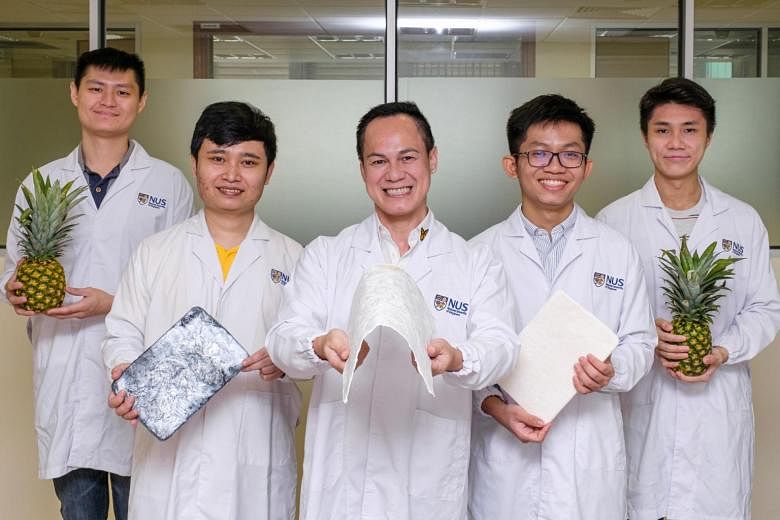SINGAPORE - Researchers at the National University of Singapore (NUS) have discovered an environmentally friendlier way to treat waste water and preserve food by turning pineapple leaves into biodegradable aerogels.
Aerogels - often made of silica - are commonly used as oil absorbents and in heat insulation applications. But their manufacture releases toxic quantities of carbon dioxide into the atmosphere.
Pineapple leaves, which are a waste product of pineapple harvests, can also release harmful chemicals and greenhouse gases when they are burned or left to rot.
Associate Professor Duong Hai-Minh, who leads the team of nine researchers from the NUS Faculty of Engineering's Department of Mechanical Engineering, said: "For every 1kg of pineapple harvest, 3kg of waste in pineapple leaves are generated, making it one of the highest rates of agricultural waste in the world. So we decided to explore how we can convert these leaves into producing aerogels."
To reduce waste and promote environmental sustainability, the researchers started off upcycling different types of waste, such as paper, textile, plastic and rubber, into multifunctional aerogels.
They have since received an intellectual property licence for their technology.
Since venturing into agricultural food waste research in 2016, the researchers have also explored the use of other byproducts - such as sugarcane bagasse and coffee grounds - to create reusable eco-aerogels, which are now in the process of commercialisation.
The fabrication process for the eco-aerogels, which takes around 12 hours, generally involves shredding the material and mixing it with water and a small amount of non-toxic chemicals before freeze-drying it.
A sheet that is 1 sq m in area and 1cm thick costs less than $10 to produce. It can be sold for between $30 and $50 when it is commercialised in a few years.
Comparatively, a silica aerogel sheet of the same size costs around $40 when purchased in bulk and takes around six to seven days to produce.
When coated with activated carbon powder, the aerogels can slow down the ripening process of fruit - such as banana, mango and papaya - and vegetables.
Ethylene gas, which is considered a "fruit-ripening hormone", is absorbed by the aerogel and the ripening process of fresh produce is delayed by at least 14 days. The modified aerogel can absorb six times more ethylene compared with commercial absorbents.
Professor Nhan Phan-Thien, a senior member of the research team, said: "Vast quantities of fresh agricultural produce are discarded due to inadequate post-harvest storage and processing facilities, as well as inefficient or disrupted transportation systems. Therefore, cutting down spoilage can go a long way in reducing waste."
In addition, compared with conventional methods, the aerogels can remove four times more nickel ions in industrial waste water when coated with a chemical known as diethylenetriamine.
.
Different chemical coatings can be used to enable the aerogels to extract various types of heavy metals from aqueous solutions.
The team has since filed a patent for the production of these eco-aerogels and has plans to work with industry partners Mapletree and DP Aerogel to scale up and commercialise its technology.


